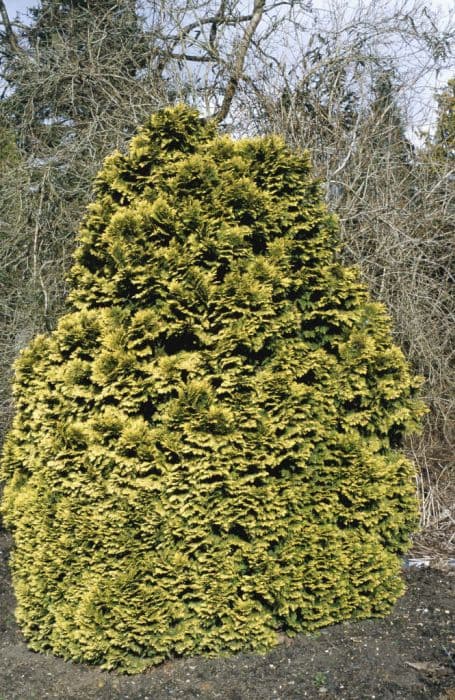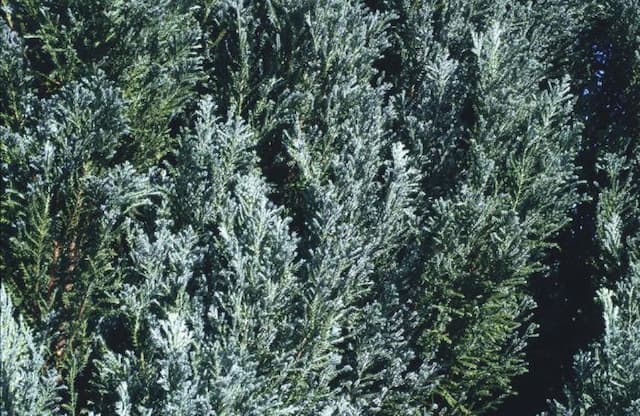Japanese cedar 'Elegans Aurea' Cryptomeria japonica 'Elegans Aurea'

ABOUT
'Elegans Aurea' is a slow-growing, upright, evergreen conifer forming a large shrub, or small tree, up to 10m high. It has cinnamon-coloured bark and bright green, feathery, juvenile foliage turning yellow-green in winter
About this plant
 Names
NamesSynonyms
Japanese Cedar, Sugi, Golden Japanese Cedar, Elegans Aurea Japanese Cedar
Common names
Cryptomeria japonica 'Elegans Aurea'.
 Characteristics
CharacteristicsLife cycle
Perennials
Foliage type
Evergreen
Color of leaves
Green
Height
10-12 feet (3-3.7 meters)
Spread
10 feet (3 meters)
Plant type
Tree
Hardiness zones
7
Native area
Japan
Benefits
 General Benefits
General Benefits- Ornamental Value: Japanese cedar 'Elegans Aurea' boasts visually appealing golden foliage that enhances garden aesthetics throughout the year.
- Shade Provider: Its dense growth habit makes it an excellent source of shade in landscapes and gardens.
- Habitat for Wildlife: The tree can act as a habitat for birds, providing shelter and nesting sites.
- Privacy Screen: With its thick foliage, it can serve as an effective natural privacy barrier between properties.
- Erosion Control: The extensive root system of the Japanese cedar helps stabilize the soil and prevent erosion.
- Low Maintenance: Once established, it requires minimal care, making it a convenient option for gardeners of all skill levels.
- Winter Interest: Retains its color and structure in winter, providing visual interest in the landscape during the colder months.
- Drought Tolerance: Once established, it can withstand periods of drought, making it suitable for xeriscaping.
- Sound Barrier: The dense foliage can help dampen noise, creating a more peaceful garden environment.
- Windbreak: The tree can serve as a windbreak, protecting other plants and areas from strong winds.
 Medical Properties
Medical PropertiesThis plant is not used for medical purposes.
 Air-purifying Qualities
Air-purifying QualitiesThis plant is not specifically known for air purifying qualities.
 Other Uses
Other Uses- Cryptomeria japonica 'Elegans Aurea', commonly known as Japanese cedar, can be used in bonsai cultivation due to its aesthetic foliage and ability to be pruned into various miniature tree shapes.
- Wood from the Japanese cedar can be utilized in the crafting of traditional Japanese teahouses, owing to its resistance to rot and serene, clean appearance
- The lightweight and durable wood of the Japanese cedar is often used in making certain musical instruments, such as the koto, a traditional Japanese stringed instrument.
- Foliage from the Japanese cedar can be employed in the creation of essential oils that are used for aromatherapy to evoke a calm and relaxing atmosphere.
- Wood shavings and sawdust from the Japanese cedar can be used as natural mulch in gardens to retain soil moisture and add a decorative touch.
- Juvenile foliage of the Japanese cedar, with its distinctive color and soft texture, can be included in floral arrangements to add a unique touch.
- The wood of Japanese cedar is sometimes crafted into sake cups or barrels, which can impart a subtle aroma and flavor to the sake.
- In woodworking, thin slices of Japanese cedar are used to make decorative veneers for furniture and interior decoration, highlighting the wood’s natural grain and color variations.
- Juvenile shoots of the Japanese cedar can be collected to make a natural green dye for textiles, offering a sustainable alternative to synthetic dyes.
- The bark of the Japanese cedar can be used in the production of a type of traditional Japanese paper called 'Washi', known for its strength and durability.
Interesting Facts
 Feng Shui
Feng ShuiThe plant Japanese Cedar is not used in Feng Shui practice.
 Zodiac Sign Compitability
Zodiac Sign CompitabilityThe plant Japanese Cedar is not used in astrology practice.
 Plant Symbolism
Plant Symbolism- Longevity and Perpetuity: Cryptomeria japonica 'Elegans Aurea', commonly known as Japanese Cedar, is a species that can live for centuries, symbolizing long life and endurance.
- Sacredness: In its native Japan, the Japanese Cedar is often found near temples and shrines, signifying sacredness and spiritual significance.
- Strength: The Japanese Cedar is a robust and hardy tree that withstands various conditions, representing strength and resilience.
- Peace: The tree's evergreen nature and tranquil green can symbolize peace and tranquility.
- Rejuvenation: 'Elegans Aurea' has foliage that changes color, often starting as golden in its youth before turning green, which can symbolize renewal or rejuvenation.
 Water
WaterThe Japanese Cedar 'Elegans Aurea' prefers consistently moist soil, so it is important to water it thoroughly when the top layer of soil feels dry to the touch. This might mean watering once a week during periods of drought or less frequently during rainy seasons. Make sure to provide deep watering, which encourages roots to grow downward; this could amount to around 1 to 2 gallons for young trees every week during dry spells. During the winter, reduce the amount of water to match the plant's reduced growth rate and prevent waterlogging.
 Light
LightThe Japanese Cedar 'Elegans Aurea' grows best in full sun to partial shade. An ideal spot would provide a minimum of four hours of direct sunlight each day, with some dappled shade during the hottest part of the afternoon. However, the plant can tolerate a range of light conditions, and too much hot, intense sun can sometimes scorch the foliage, particularly in hotter climates.
 Temperature
TemperatureThe Japanese Cedar 'Elegans Aurea' is hardy and can handle a range of temperatures, surviving minimum temperatures of around -20°F. It grows optimally in temperatures between 40°F and 70°F. While it can endure short periods of heat above 90°F, prolonged exposure to extreme heat could stress the plant.
 Pruning
PruningPruning the Japanese Cedar 'Elegans Aurea' is primarily for shape and health, removing any dead or diseased branches. It can be pruned in late winter or early spring, just before the new growth begins. This is a less vigorous grower so it doesn't require frequent pruning, but an annual check to remove any problematic branches is a good practice.
 Cleaning
CleaningAs needed
 Soil
SoilJapanese Cedar 'Elegans Aurea' thrives best in acidic to neutral soil with a pH range of 5.0 to 7.0. The ideal soil mix should be well-draining with a combination of peat moss, perlite, and pine bark for optimal root health.
 Repotting
RepottingJapanese Cedar 'Elegans Aurea' should be repotted every 2 to 3 years to ensure healthy growth. Younger plants may require more frequent repotting, while older, more established specimens can be repotted less often.
 Humidity & Misting
Humidity & MistingJapanese Cedar 'Elegans Aurea' prefers moderate to high humidity levels. Maintaining a humidity level around 50-60% is ideal for this plant to grow healthily.
 Suitable locations
Suitable locationsIndoor
Not suited for indoor growth; prefers full/partial sun outside.
Outdoor
Plant in full to partial sun with well-draining soil.
Hardiness zone
5-7 USDA
 Life cycle
Life cycleCryptomeria japonica 'Elegans Aurea', commonly known as Japanese Cedar, begins its life cycle as a seed, housed within a cone that opens to release the seeds, typically in the fall. After germination, which requires well-drained soil and partial to full sun, the seedling emerges, exhibiting initial juvenile foliage that is soft and light green. As the seedling grows into a sapling, it develops into a pyramidal shape with somewhat dense foliage that turns golden-yellow during the growing season. The tree matures over several years, showing more of the bright golden color for which 'Elegans Aurea' is named, and gains height and girth, with bark that becomes deeply furrowed. The mature Japanese Cedar will eventually produce male and female cones on the same tree (monoecious); pollen released from the male cones fertilizes the female cones to produce seeds. The tree's life span can extend over several centuries if growing conditions are optimal and it is not subject to disease or adverse environmental conditions.
 Propogation
PropogationPropogation time
Spring-Early Summer
The most popular method for propagating the Japanese Cedar, Cryptomeria japonica 'Elegans Aurea', is by taking semi-hardwood cuttings. This is typically done in late summer to early fall. To propagate by cuttings, a healthy branch is selected, and a cutting of about 4 to 6 inches (10 to 15 centimeters) long is taken with several nodes. The lower needles are stripped off, and the cut end is often dipped in rooting hormone to encourage root development. The cutting is then inserted into a mix of half peat and half perlite or a similar well-draining rooting medium. The cutting needs to be kept in a humid environment with indirect light and consistent moisture. With proper care, roots usually form within a few months, after which the new plants can be transplanted into individual pots or their final location in the garden.









